Issue:September 2017
SPECIAL FEATURE - Injectable Drug Delivery: New Technologies Deliver Biologics & Differentiate Brands
The increasing use of biologics, a rise in the prevalence of chronic diseases, increasing occurrence of needlestick injuries, and the benefits of injections (convenience, ease of use, and reduced pain) are increasing the demand for safety syringes, prefilled syringes (PFS), and autoinjectors.1 Thus, the global injectable drug delivery market is projected to reach $624.50 billion by 2021, up from $362.38 billion in 2016.
At the center of developing injection device designs is human engineering inputs and patient preference research. It behooves a pharmaceutical company to work closely with device developers to influence therapeutic product decisions and create devices that differentiate brands, prevent packaging and drug interactions, and ensure patient adherence.
However, many hand-held devices are only capable of administering drugs with dosing volume close to 1 mL. With more than 900 biologics being developed (most of these are highly viscous and are required to be delivered in volumes greater than 1 mL), there is a growing demand for self-administration devices than can overcome this unmet need. Large-volume wearable injectors, an advanced version of the existing self-injection devices, are expected to gather interest from a wide customer base.2
This year’s Drug Development & Delivery injectable device report showcases the features of newly developed, and soon-to-be-commercialized technologies that address the issues of ease of use, high viscosity delivery, and brand differentiation.
Aptar Pharma: Committed to Lowering Particulate Levels
As more complex and expensive drugs — including complex proteins — are developed, the challenge for organizations like Aptar Pharma is to deliver higher standards of cleanliness in elastomeric components. For more than 50 years, Aptar Pharma has been developing elastomer solutions and its formulations feature best-in-class extractable and leachable profiles, says Adam Shain, Director of Global Business Development Injectables, Aptar Pharma. “But we recognize we need to continue to go further and our PremiumCoat™ offer takes our commitment on lowering extractable levels and particulates to even greater levels of reassurance.”
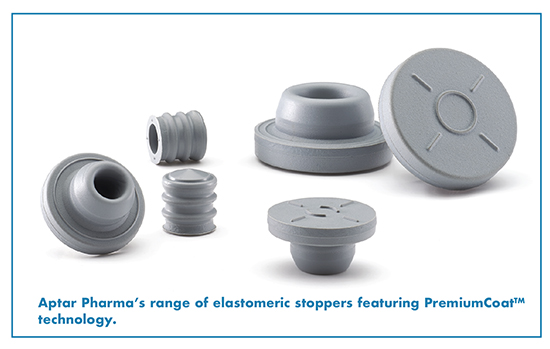
PremiumCoat are film-coated elastomeric plungers and stoppers that represents a step change by reducing particulate levels. “The Particulate Count Index (PCI) achieved today is an unrivalled, market leading PCI of 1.3, compared to the market gold standard of 2.9,” says Mr. Shain.
PremiumCoat features a Fluorinated (ETFE) film that is applied during the manufacturing process. This approach delivers a completely homogenized coating, resulting in a more effective barrier than some rival coating technologies, Mr. Shain says. This makes the component easier to inspect with automated vision systems. The process also ensures that only the area that comes into contact with the drug is treated, ensuring security of closure.
PremiumCoat is available in Ready to Sterilize (RTS) and Ready to Use (RTU) variants. The RTS product is designed for organizations that have sterilization facilities in place. PremiumCoat is compatible with steam sterilization and uses Aptar Pharma’s proprietary washing process.
The RTU product is sterilized by gamma irradiation, which provides flexibility and convenience. There is a reduction in the number of human operations as well as improved productivity, as the stoppers may be used immediately and can be directly placed into RABS or isolators. In addition, gamma sterilization is proven to be a more effective means of sterilizing stoppers than steam sterilization. Gamma irradiation has the advantage of sterilizing the vial stoppers while they remain in their packaging, limiting contamination risks during transfer, eradicating moisture, improving productivity, and controlling exposure, says Mr. Shain.
Manufacturing is housed in two mirrored sites, both based in France. Both sites are fully compliant with international regulations ISO 15378:2011, as well as three Drug Master Files (type III and type V). To be closer to its customers in the United States, Aptar Pharma has invested in a new manufacturing facility in Congers, NY.
Bespak: Focused on Self-Injection Devices for a Variety of Volumes & Viscosities
The demand for injection devices with increasingly advanced and automated features that support self-administration has Bespak focusing on expanding its VapourSoft™ powered Syrina™ range of injectable devices. The range spans simple assisted syringes to fully automatic autoinjectors, and is capable of handling drug formulations of different viscosities and volumes, explains Steven Kaufman, Bespak’s Global Business Development Lead.
When creating injection devices for self-administration, it’s important that the design easily allows the patient to deliver the correct dose, with minimal discomfort to improve compliance. Adding safety features such as automatic needle insertion and retraction help to make the process simpler for some patient groups, and also reduce the risk of needlestick injuries.
For example, Syrina S has a small form factor, is suitable for 1 mL or 2.25 mL syringe, and has a user-controlled needle insertion and removal mechanism. Syrina AS is primarily set to be a 2.25 mL autoinjector featuring automatic needle insertion with an initial extension. Syrina AR is a fully automatic autoinjector and is the latest addition to the range. Launched in October 2016, Syrina AR 2.25 mL offers automatic needle insertion, drug delivery, and needle retraction, with a single push-on-skin operation. These devices are specifically designed for use with high-value biotherapeutics ($100 or more per injection), with viscosities from aqueous solutions to those that are hundreds of centipoise (cP), and a range of injection volumes from .2 mL to 2 mL.

For delivery of biologics, Bespak offers two power sources for drug delivery devices. The Syrina and Lapas™ ranges of injectable devices use Bespak’s proprietary compact energy source, VapourSoft, a miniaturized canister of liquefied gas, designed to deliver viscous drug formulations in a smooth manner, minimizing discomfort for patients as well as providing solutions that can manage injections with cP in the hundreds to thousands with next-generation enhancements. Bespak’s proprietary spring-based autoinjector technology offers solutions for viscous injectables, with a device launched last year in Europe that can inject the highest viscosity in a 1 mL PFS device configuration, says Mr. Kaufman.
“The injection devices we develop for our customers are driven by patient feedback and input from human factors experts, invited at an early stage in the design process,” says Mr. Kaufman. “To create an injectable device that’s easy and safe to use, we focus on creating ergonomic designs that accommodate the needs of the specific patient group.”
The external appearance of Bespak’s injectable devices are highly customizable, allowing collaboration with pharmaceutical customers to address preferences for style and incorporate their company branding, in addition to meeting patient needs. Mr. Kaufman says Bespak is seeing greater demand for sleek and compact solutions, as well as designs that offer differentiation from competitors. In addition, he says there is a strong desire from pharmaceutical customers for platform devices such as autoinjectors that can use either 1 mL or 2.25 mL PFS, and require only one component change.
Biocorp: Connected & Passive Devices Reassure Patients
During the past three years, Biocorp has developed a range of connected devices in the field of injection to help patients better manage their diseases. These include: Datapen, a reusable electromechanical pen injector, compatible with standard cartridges, that automatically records each dose injected and sends the information in real-time to a mobile app or a data platform; and Easylog, a smart sensor (or smart cap) that turns regular pen injectors into connected devices. The system is compatible with all major pen platforms and automatically collects each dose injected with a 100% level of accuracy, says Eric Dessertenne, COO of Biocorp.
Several development programs are now active on these two products in various therapeutic areas: diabetes, growth hormone, Parkinson’s, and rare diseases. Connected solutions ease self-administration by guiding the patient in every step thanks to visual and audio signals and provide them with feedbacks and monitoring solutions through the app.
Datapen can be specifically helpful for the delivery of biologics, says Mr. Dessertenne. “First, it provides a high level of accuracy (0.5 microliter), which is a key requirement for the administration of certain biologics. Additionally, many biologics are high-viscosity products and need reconstitution before the injection. Datapen can significantly ease reconstitution processes thanks to electro-mechanical features and user instructions directly on the screen to minimize human errors.
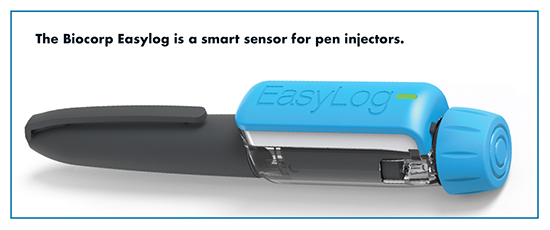
To bring connectivity to the injection field, Biocorp offers integrated solutions or “add- ons.” “Integrated solutions are devices natively designed with embedded elecryonic features,” explains Mr. Dessertenne. “Their form, shape, and process are like regular products on the market, but they incorporate electronics and can communicate treatment information in real time to a mobile app or data platform. Add-ons are smart sensors that can be attached to regular devices on the market, turning them into connected products. Typically, these require no modification to the existing devices and have no impact on the regulatory and industrial processes. It solves an important issue for pharma companies: Bring connectivity to disposable pen injectors. The add-ons can be reused over two years on several disposable devices, making it a cost-effective solution.”
Aside from connected devices, Biocorp is launching a passive safety system for prefilled syringes, the NewGuard, directly integrated to the PFS with no impact on regulatory and industrial processes. The ultra-compact version fits 0.5 mL and 1 mL PFS, with the same device. NewGuard will replace the rigid needle shield and will be assembled in the syringe manufacturer’s production line.
Mr. Dessertenne says that human factor and user studies have a major impact on the way Biocorp designs and develops its products, including NewGuard. Its shape is similar to a traditional PFS but looks less daunting and more familiar, making patients feel safe before, during, and after injections.
“At an early stage of our developments, we gather feedback from end users and integrate them in the design phase,” he says. “First, we have understood the importance of reducing the number of steps for the patients and design products with seamless integration. Second, we have identified a need for additional comfort and security in the field of injection.”
The Credence Companion® platform offers pharmaceutical and biotech customers an accelerated path to commercialization of a delivery system that can drive market differentiation and minimize risk by providing compliance, says Mark Hassett, Vice President, Business Development, Credence MedSystems. The Companion platform offers a pre-attached needle, a use-attached solution (luer lock), and multiple dual-chamber reconstitution offerings.
“Across the lineup, the user has a consistent experience that blends the familiarity of conventional syringes with important usability advantages,” says Mr. Hassett. “Multiple human factors evaluations have been performed on Companion syringes. Feedback indicates that users are consistently impressed with the ease and intuitiveness-of-use, as well as the syringe functionality, and that users strongly value the information provided by the syringe’s feedback cues.”
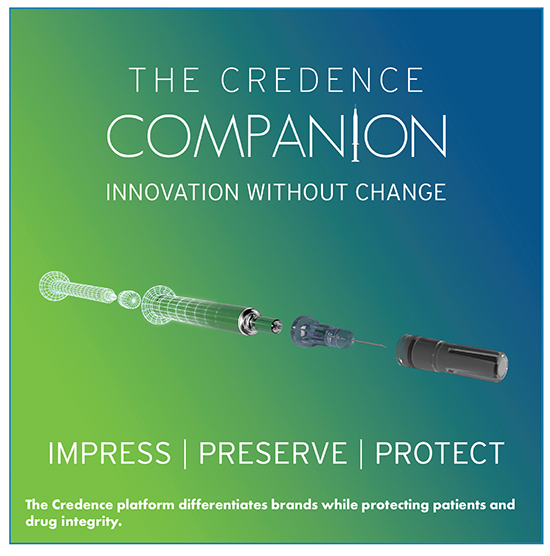
Additionally, Mr. Hassett claims that Credence’s technology allows pharma to provide end users with the benefits and market differentiation while preserving freedom to maintain sourcing strategy and supplier preferences. Pharma manufacturers can select their preferred primary package container and their choice of components (stoppers, needle shields, tip-caps) from their preferred suppliers. “Pharma’s ability to choose the design elements they already use and have previously validated minimizes disruption to their development, regulatory, and supply chain efforts,” he says. “The Credence approach also preserves pharma’s current aseptic filling manufacturing processes while removing incremental costs and investment related to secondary packaging.”
Companion also features a passive, integrated needle retraction system. Upon completion of the injection, the user hears and feels the end-of-dose click and then the needle is automatically retracted through the stopper and into the plunger rod/glass barrel. The syringe is thereby disabled from reuse. “The Companion technology helps protect healthcare protectors, self-injectors, and those downstream from accidental needlestick and the potential spread of infectious disease,” says Mr. Hassett. “It also protects patients from being exposed to disease through syringe reuse.
However, the less obvious, yet equally critical, protection the Companion provides is to the integrity of the drug. Credence eliminates glue from the needle-attachment mechanism. “This vital improvement over the age-old conventional approach eliminates the risk of any unwanted interaction between glue and drug product and enables silicone-controlling techniques that were previously incompatible with staked syringes. By protecting the integrity of the drug, the Companion system has become an enabling technology for the industry’s sensitive biologic drugs.”
DALI Medical Devices: Auto-Needles for Biosimilar & Generic Pharma
In the past year, DALI has been focused on developing customized versions of its SAN-Light premium passive-automatic safety needle and the SAN-L automatic needle insertion device for a specific pharma company; progressing the design of the SAN-DV Pro and SAN-DV drug transfer, reconstitution and injection systems; working with Elcam Drug Delivery Devices (E3D) on developing various disposable and reusable next-generation autoinjectors, with customization projects for a number of major pharma and biosimilar companies; and developing an injector for pharmaceuticals to the posterior segment of the eye.
During development of the various injectors, DALI conducts human factor studies to get input from target potential users, whether they are self-injecting patients, caregivers, nurses, or physicians, says David Daily, MSc, MBA, CEO & Co-Founder of DALI Medical Devices.

“As an example, during one of our recent studies of the customized SAN-Light performed with a pharma client, we found that some nurses would prefer not only to see the tip of the needle before giving an injection, allowing easy priming and orienting the needle at the injection site, but would also like to see the needle has been completely removed after injection (so nothing is left in the body),” he says. “To achieve such an easy view of the needle after withdrawal from the skin and passive retraction of the needle guard has occurred, a few design modification options were proposed, and one modification that does not increase cost of goods was chosen.”
Addressing patient-centered challenges in injectable drug delivery, all SANs (excluding the SAN-Light) feature automatic needle insertion, passive-automatic sharps protection, and a needle that is hidden at all times. And SAN products combine these features with manual control of injection speed for maximum comfort.
In addition, depending on the configuration and the pharma clients’ preferences, the SANs are packed either in a blister pack or an injection-molded cap sealed with a Tyvek® lid. These designs allow either separate unit package or kit- packaging together with the drug, depending on the client requirements. The package designs allow also EtO (ethylene oxide) or gamma-irradiation sterilization processes, when required.
Datwyler: Understanding & Improving Syringe Performance
The therapeutic biologics industry has been growing significantly over the last few years. In 2015, more than 3 billion prefilled syringes were sold worldwide. While anticoagulants and vaccines traditionally dominated the PFS market, the number of biologics stored and administered in prefilled syringes today is constantly increasing. This also triggers a growing complexity of formulations and the surge in novel device designs.
“Due to the sensitivity of biologics during storage and their complexity during administration, primary packaging components used for biologics are facing demanding requirements than those used for any other kind of injectable drug,” says Rahul Thakar, PhD, Technical Key Account Manager, Datwyler Sealing Solutions. “Prefilled syringes (including the glass barrel and the elastomeric closure) need to act as a chemically inert and secure delivery system. The rise of autoinjectors and the integration of additional safety features add to this complexity. That’s why manufacturing of primary packaging materials is considered to be an extension of the drug manufacturing process.”
The impact of elastomeric plunger design on syringe delivery forces is a complex problem that depends on the material properties of the elastomer, the lubrication system, the plunger rod design, the aging conditions, and the drug formulation properties. Furthermore, challenges like needlestick injuries, silicone sensitivity, and the need for consistent delivery forces have to be considered. Finite Element Analysis (FEA) is a powerful tool for building a fundamental understanding of how the components of a prefilled syringe increase the overall performance of the system.
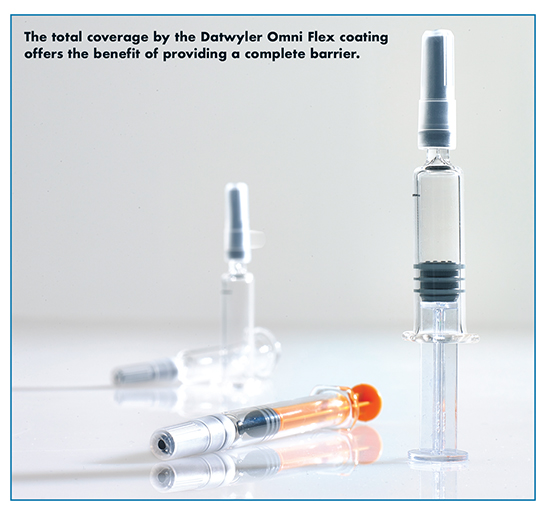
As a partner for biotechnology, pharmaceutical, and medical device companies, Datwyler provides customized solutions, from early developmental stages through scale-up to full production. For example, with biologic drugs, a major concern is the generation of proteinaceous particles (prions) in prefilled syringes. Under certain circumstances, therapeutic proteins can interact with syringe components, and in particular with the silicone oil that is typically used as a lubricant on both the barrel and the plunger. To mitigate such risks, Datwyler uses lubricious barrier Omni Flex coatings, which do not require siliconization. Omni Flex Coated Plungers utilize a proprietary, flexible fluoropolymer spray coating technology designed to be an inert barrier and impart a low coefficient of friction. This barrier function directly relates to an even cleaner extractable profile.
“The lubricous nature of the coating supercedes the need for siliconization that directly translates into highly consistent delivery forces – a must for self-administration,” says Dr. Thakar.
As a development partner of elastomeric components, Datwyler recently developed a customized solution for a wearable injector. A custom plunger and septum with fluoropolmer coating was needed that requires the lowest level of particulate with highly functional requirements and chemical compatibility with biological drugs, says Dr. Thakar.
“Combining wearables with drug administration could result in new therapeutic measures and devices, for example for the treatment of diabetes,” he says. “A wearable insulin pump can directly and independently administer the exact amount of insulin the patient needs.”
EG-GILERO: Partnering With Pharma to Design Devices
EG-GILERO doesn’t market its own products, but partners with pharmaceutical and device companies to design, develop, and manufacture devices. Most devices are disposable, both multi- and single-use, but occasionally they work with reusable systems like IV pumps, syringe pumps, and novel variants, explains Jim Fentress, Director of Engineering, EG-GILERO. Therapeutic applications vary, typically addressing parenteral routes, as well as ophthalmic and implantable systems.
Human engineering inputs and patient preference research affect EG-GILERO’s designs, depending on their intended use. “For example, dental syringes need to inject into tissues with substantially higher back pressures than intradermal or intramuscular syringes,” says Mr. Fentress. “This drives designs, which lower the required application force while still achieving injection pressures. Simultaneously, the higher injection forces drive ergonomic considerations that will make the syringe easier to activate and maintain position during injection.” Self-administration devices are always driven by specific needs of target populations, Mr. Fentress says. “When designing these devices, a fundamental understanding of the population and concomitant health problems is critical. The most effective solutions start out by exposing device concepts and variants to the target population early in the process. This kind of development effort avoids making mistakes that are expensive to correct later.”
As important as the design is the packaging. Packaging is product specific and driven by primary considerations. Does the packaging have to be a sterile barrier? Does the package prevent some form of device activation (i.e. preventing a permanent needle guard from triggering)? Does the package provide long-term device protection (i.e. an autoinjector that might be carried in a backpack)?
Typically, disposable devices gravitate towards the most cost-effective solutions. An exception exists for devices intended for non-clinician use. For these devices, the packaging often becomes an integral part of the instructions for use, directing untrained individuals towards safe and effective application. Most disposable injection devices developed by EG-GILERO incorporate needle shielding or lock-out to prevent injury.
Enable Injections: High-Volume Drug Delivery Supplants IV Infusion
Enable Injections has been developing large-volume (up to 50 mL) wearable injectors for subcutaneous delivery of high-viscosity formulations. In addition, Enable Injections is developing easy-to-use systems that facilitate the rapid transfer of biologics and drugs from their original primary container closure to its wearable injectors.
“Our transfer systems were designed to warm the refrigerated biologic/drug products to room temperature through simple convection (no heating elements), thus reducing the typical 30- to 45-minute patient wait time,” says Mike Hooven, President and CEO of Enable Injections.
Although the wearable large-volume injection systems are not yet approved or commercialized, Enable Injections’ devices have undergone numerous human factors tests and evaluation protocols as well as user market research. The wearable large-volume injectors are purely mechanical and designed for ease of use with the ability to initiate injections in three simple steps, explains Mr. Hooven. The injection device has a smooth, low-profile exterior with rounded components that prevent the device from catching on clothing. The device adheres readily to the skin. Patients then press the injection button to initiate subcutaneous injection. When the injection is complete, the button and needle automatically retract with an audible “click” and the device is then easily and safely removed. The device also allows patients to actively pause their injection by holding down the button.
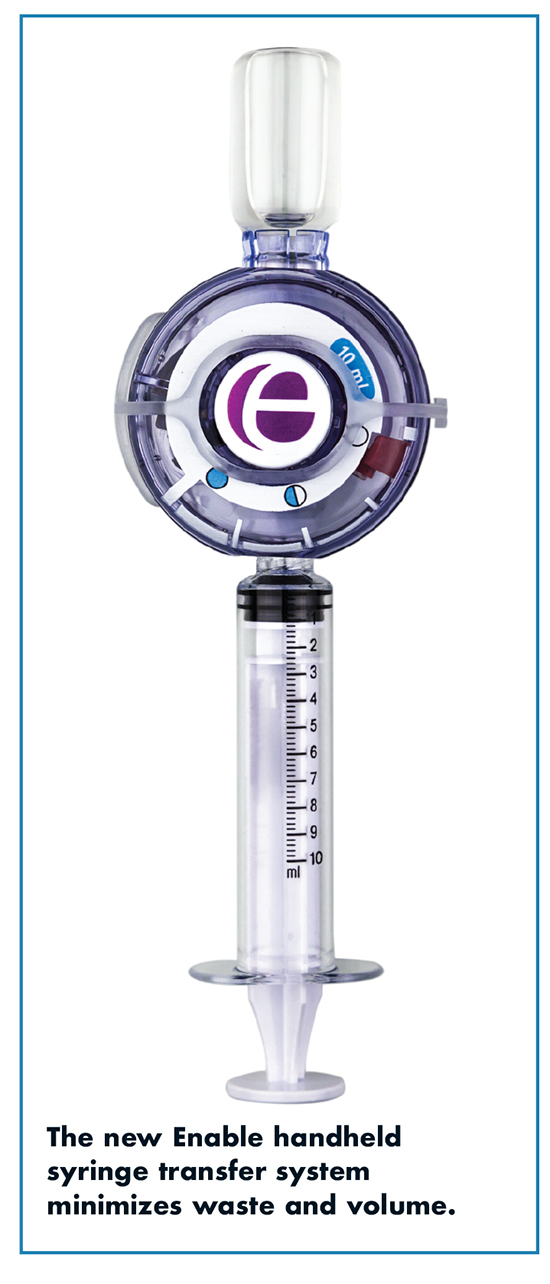
“Of note, Enable Injections’ system is designed to supplant the need for IV infusion of biologics in many cases, and reduce monetary costs and time burden of establishing an IV infusion of a biologic by healthcare professionals,” says Mr. Hooven. “Our ability to use any standard pharma industry container closure with a delivery system that is preferred by patients and caregivers saves costs and reduces drug development time by months. Also, by pairing standard container closure systems with our injection system, the clinician is afforded the flexibility to establish effective dose regimens tailored to the individual patient when needed.”
Mr. Hooven adds that Enable Injections has designed its packaging around the concept of simplicity of use, which reduces the volume of hardware and requisite instructional material compared with more complex electro-mechanical drug delivery systems. “Ultimately, the products’ packaging focuses on minimizing waste and volume while accommodating a single-use, disposable device that ensures a safe and sterile environment for biologic/drug delivery.”
Enable injections has partnered with Flex to develop the Enable Smart Device, a next generation communication device that uses Bluetooth Low Energy technology by means of broadcast mode. The Enable Smart Device can be pre-integrated into a company’s Digital Health Platform, giving Enable’s pharma partners immediate access to patient data across multiple devices and gaining direct engagement with patients to drive adherence. “The Enable Smart Device adheres to our overall strategy of designing simple systems for maximum effectiveness with minimal interaction,” Mr. Hooven says.
Gerresheimer: Reducing Interactions Between Drug & Container
Primary packaging for parenteral formulations has strict requirements with regard to the likelihood of component/dosage form interactions, especially for biotech-based and other sensitive drug products. New product developments at Gerresheimer reflect this trend.
Gerresheimer offers a range of prefillable COP syringes produced by its long-standing Japanese partner, Taisei Medical Co. Ltd. The company is now extending its portfolio of the new Gx RTF® ClearJect syringe, available in a 1 mL-long version, using standard rigid needle shield and fluoropolymer-coated plunger stoppers. “Biotechnologically developed drugs pose challenges for the container, as they can be very sensitive,” says Bernd Zeiss, Manager Technical Support Medical System, Gerresheimer. “There may be interactions with syringe components such as tungsten, silicone oil or the barrel material itself. Using a barrel material such as COP may have advantages with a drug compared to a glass syringe.”
Addressing the unmet needs in prefillable syringes is the key to successful pharma products. The metal-free syringe with a high quality luer lock adapter (TELC) is a good example of how Gerresheimer finds solutions for its pharma clients. “Solving the tungsten issue is an important step to minimize syringe container-induced interactions with a sensitive drug,” says Mr. Zeiss. “Substituting the tungsten pin used in the manufacturing of glass syringes with an abrasive-free and non-cytotoxic ceramic extends the range of biopharmaceuticals that can be administered by means of a prefilled syringe.”
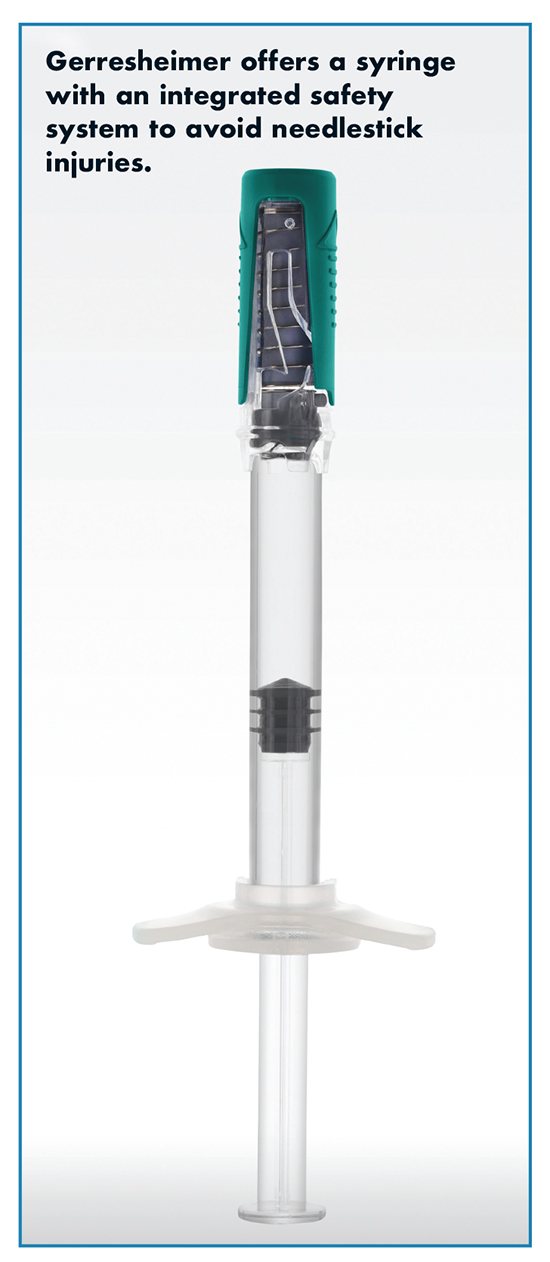
Reducing silicone oil is another customer need addressed by Gerresheimer. The Gerresheimer Gx RTF baked-on siliconization reduces the silicone levels significantly and make the syringe suited for sensitive biopharmaceuticals as well as for the stringent ophthamologic USP requirements with regard to subvisible particle loads, Mr. Zeiss says.
Gerresheimer will complete its product portfolio of prefillable syringes made of glass and plastics with an integrated, passive syringe safety solution, acquired through an exclusive license from West Pharmaceutical Services, Inc.
Haselmeier: New Product Platform is Suited for Clinical Trials
The D-Flex Pen is a disposable pen for use with 3 mL cartridges. The D-Flex can be configured for several fixed doses, bridging the gap between fixed and variable-dose pens. These dose values can be freely selected when designing the pen. This is especially of interest for dose-escalation studies. The system does not allow any intermediate settings between the set doses, reducing the risk of a wrong dose and enhancing safety for the patient, says Konrad Betzler, Chief Pharma Officer at Haselmeier, GmbH.
“The D-Flex pen means that only one device needs to be used throughout the clinical trial, making trials much easier for the pharmaceutical company,” says Mr. Betzler. “Regulatory bodies may impose a device design that enables dial-labelled doses, which would disqualify the use of current prefilled pens that have intermediate dose increments.”
Using D-Flex for clinical trials, and later as serial device, means that the customer has the freedom to decide the preferred set-up for market introduction. Mr. Betzler says: “This makes the D-Flex the ideal, flexible platform for adapting to set doses in accordance with the therapy.”

Additionally, the platform has been developed and validated so that only minimal molecule-specific and customer-specific adjustments are necessary; they can be integrated into the clinical supply chain process seamlessly up to serial production following market authorization.
Haselmeier has also integrated final device assembly into its operations and can now provide finished combination product supply. “This capability adds significant value to our customers by further simplifying and integrating the supply chain process,” says Terence O’Hagan, General Manager of Haselmeier, Inc.
Nemera: New & Improved Platforms Feature Add-On Safety Devices
Nemera has developed Safelia®, two-step autoinjector platforms for subcutaneous and intramuscular injections of fluid and viscous formulations. Thanks to its patented cam-driven mechanism, injection force and speed can be adjusted by design to fit formulation and patient needs. Safelia allows delivery of viscous formulations through thinner needles (up to hundreds of centipoises). Disconnect needle insertion and syringe emptying allow drug delivery at the right depth, limit the risks of glass breakage, and ensure safety, says Adrien Tisserand, Nemera’s Global Category Manager for Parenteral.

He says: “The Safelia autoinjector received two recognitions in 2017: The Patient Centricity & Customization Innovation Award at Pharmapack Europe; and the Editor’s Choice category at INTERPHEX.”
Nemera has also established and confirmed compatibility between the Safe’n’ Sound® platform, an add-on passive sharps injury protection device for prefilled syringes and Terumo PLAJEXTM COP prefillable syringes. “Safe’n’Sound aids in the protection from accidental needlestick injuries and facilitates the injection process through ergonomic features, such as an optional extended finger flange to improve handling, gripping, and comfort for the user,” says Mr. Tisserand.
Noble: Injection Training Improves Patient Onboarding
Noble has developed many patientcentric onboarding solutions to address the challenges stakeholders face with the growing injection drug delivery market. To address needlestick injuries and other device errors, improving patient onboarding and adherence has been Noble’s focus. This can be achieved with a variety of injection training products and solutions for standard and large-volume autoinjectors, prefilled syringes, safety systems, and on-body systems across multiple therapeutic sectors, explains Craig Baker, Executive Vice President of Noble.
“Noble follows an end-user design approach with a focus on keeping patient needs and considerations at the forefront of our development process,” says Mr. Baker. “Through collaboration with our pharmaceutical clients and OEM partners, we leverage human factor inputs throughout the development process to ensure that training and onboarding solutions maximize value and satisfy user needs. The results of putting the end user first indicate proper training and onboarding with patient-centric injection training solutions can reduce errors, increase patient confidence, decrease anxiety, and promote adherence in patients using combination therapies.”
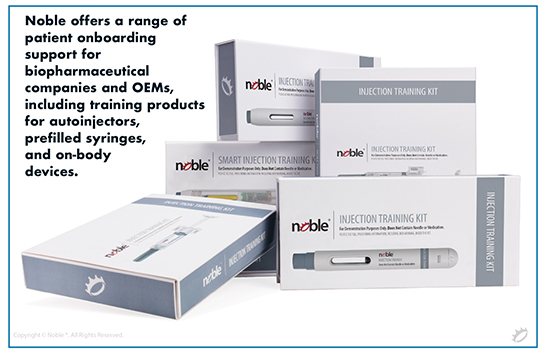
Noble takes a similar end-user approach with packaging. Mr. Baker says Noble works with pharmaceutical clients to develop packaging solutions designed to provide patients with ergonomically friendly components and mechanisms to help reduce dexterity challenges.
Noble has also developed multiple training platforms designed to connect wirelessly to smartphone applications, computers, smart packaging, and ancillary training technologies. These connected training platforms have the capability of monitoring, tracking, and guiding patients during the onboarding process. Mr. Baker says: “Smart platforms with error-correcting technologies incorporating audio and/or video training guide patients through simulated injection process using a wirelessly connected device trainer.”
Portal Instruments: A Design That Works for Patients & Processes
Portal is developing a needle-free drug delivery platform technology to transform the administration of medications and improve the patient experience for chronic diseases. Portal is targeting the subcutaneous delivery of biologics, the administration of which is typically cumbersome given the nature of their high volume, viscosity, and concentration profiles. Portal’s technology enables the administration of biologic drugs with less discomfort and delivers a 1 mL injection via a jet the size of a strand of hair in less than half a second, describes Patrick Anquetil, CEO and Co-founder of Portal Instruments. The Portal platform is also cloud-connected, providing reminders and real-time tracking of injections to improve adherence and communication between the patient and care teams.
Portal’s development process is based on a design, build, test, and iterate model throughout which Portal depends heavily on inputs of patients and expertise of healthcare providers. “We’ve run rigorous human factor studies, including contextual inquiries, formative, and other heuristic evaluations,” says Mr. Anquetil. “In-depth interviews with patient groups revealed challenges and needs, and provided valuable insight about how the device could affect their quality of life. These findings were built as inputs into the engineering design and risk assessment process.”
Feedback indicated the importance of good device handling and grip, especially among patients with limited joint mobility and dexterity. Visual cues were highlighted as necessary to facilitate the administration process. Interactions with patients indicated that they cared most about all the medication being delivered into their body. “Portal’s technology is a patient-centric, user-friendly, next-generation alternative to autoinjectors and prefilled syringes for self-administration at home,” says Mr. Anquetil. “There is no risk of needlestick injuries as there is no needle. The technology is agnostic to drug concentration and viscosity, making it well-suited to the delivery of biologics.” Lab experiments indicate that the technology can handle viscosities up to 200 cP.
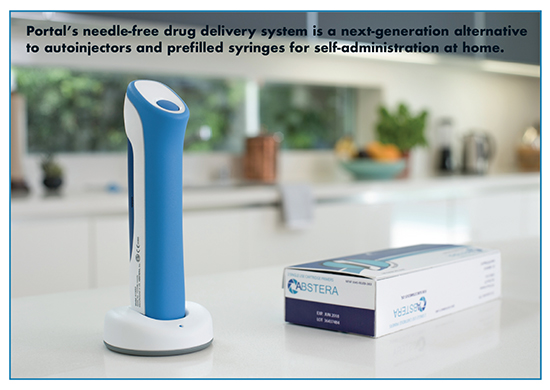
Mr. Anquetil explains that not only did the system have to be user friendly, it had to align with pharma processes. So, Portal developed a primary container that leverages the nest and tub standard and is compatible with standard pharma fill/finish lines. The patient just needs to place into the device before administering a medication.
A significant part of Portal’s value proposition is tracking medication adherence to treatment regimens. Mr. Anquetil says there is an opportunity to collect patient-reported outcomes data between physician visits that can inform treatment decisions. The first generation of devices will incorporate Bluetooth connectivity and 3G functionality to facilitate the seamless transfer of information.”
Sensile Medical AG: Subcutaneous Delivery Reduces Risk & Cost
Sensile Medical has been concentrating on two platform devices, both of which are worn on or off body with an integrated needle or a luer lock connection to an external infusion set. The SensePatch Small Volume delivers up to 3 mL from a standard cartridge whereas SensePatch Large Volume can pump up to 20 mL from an external container to an internal reservoir. Neither device is restricted to any specific indication and both are tailored to the specific needs of the correspondent therapy.
Dr. Paul Senn, Vice President Business Development of Sensile Medical AG, explains that a proprietary two-part rotary piston pump (SenseCore) is flexible in volume and material, and allows pumping and dosing of small and large molecules in viscous solution. The SensePatch devices also incorporate a proprietary needle injection and retraction mechanism whereby the needle is automatically injected/retracted immediately before/after the volume is delivered, reducing the risk of needlestick injury.
Heart failure is a clinical syndrome resulting from the inability of the heart to pump enough blood. If untreated, it may lead to peripheral edema, fatigue and difficulty breathing, and hospitalization. The majority of these hospitalized patients are just there to receive an intravenous diuretic. It is estimated that about half the patients could receive the treatment at home.

One of the most frequently used diuretics, Furosemide, is currently used in tablet form or in solution for intravenous administration. “Subcutaneously delivered Furosemide would offer a new option to treat patients with heart failure, reducing risks and costs,” says Dr. Senn.
Sensile Medical and scPharmaceuticals developed the SensePatch Large Volume device for subcutaneous administration of Furosemide. The drug-device combination uses the SenseCore technology in a wearable device that delivers the pharmaceutical drug product under the skin using a very small autoinjectable and retrievable needle. The device consists of a reusable part (containing the motor, a rechargeable battery, the hardware and software components, etc.), and a disposable part (containing the fluidic path from the reservoir, the pump to the needle).
“This innovative product is expected to provide rapid and more effective diuretic therapy that can be used at home under physician guidance when the patient experiences symptoms of decompensation,” says Dr. Senn. “It is expected that this will avert the need for emergency or in-hospital care, and for those patients who still require hospitalization, their hospital stay will be shortened and their outcomes improved.”
SHL: Patients Indicated Preference for Two-Step Autoinjectors
SHL offers a wide portfolio of devices that support the needs of its pharmaceutical and biotech partners. Within the past year, SHL has worked on a number of single-use autoinjectors using prefilled syringes or cartridges for therapeutic indications ranging from pain and obesity to autoimmune diseases. However, with the rise of biologics and the trend to prescribe less frequent injections, SHL has also focused on developing solutions that support formulations that come in larger volumes and higher viscosities.
BerthaTM, for example, is a two-step autoinjector that supports highly viscous liquids in both 1 mL and 2.25 mL volumes. The company has also developed the Rotaject® Technology to support drugs with even higher viscosities of up to several hundred centipoise. Using a patented technology to provide constant force, Rotaject ensures safety and comfort throughout the entire injection process when delivering high-volume/viscosity biologic formulations. The technology can also be used with a 1 mL or 2.25 mL disposable autoinjector.

While SHL’s injection systems have been developed to be compatible with either prefilled syringes or cartridges, its cartridge-based autoinjectors are built with Needle Isolation Technology (NITTM), which allows a needle to be pre-attached to the device. “With the needle permanently hidden throughout the entire handling process, the chances of needlestick injuries can be significantly reduced,” says Magnus Fastmarken, Global Director Marketing, SHL.
In addition to reducing needlestick injuries, the patient is at center of device design at SHL. “One of the key findings from our human factor research shows that simple two-step devices are the most preferred by the majority of patient groups,” says Mr. Fastmarken. “By eliminating the activation button, we are able to improve usability while minimizing the need for training.” Human factor elements also support packaging configurations, handling and opening of the carton, and retrieving the device, to determine how to best support the patient population.
To collect and further analyze real usage data, SHL has invested in a new design center that will include an in-house interview studio for recording and documenting the patient experience and feedback in human factors and usability studies.
In fact, SHL’s pipeline includes several patented sensors that can be used to collect and share data. One of them is the Molly C Recording Unit, a concept design that demonstrates how connectivity can be utilized in an existing autoinjector to collect real user data, including time, date, and potentially location. “While the unit can be paired with a smartphone to support patient adherence, the concept is part of a larger cloud-based system that allows us to offer additional value for other stakeholders such as pharma companies, clinical researchers, and payers,” says Mr. Fastmarken. “For example, some of the areas that we are currently exploring include improving patient experience, learning, and treatment. We are also looking at wireless connectivity as a means to enable device traceability, life-cycle management, and more.”
Mr. Fastmarken explains how Molly was recently used with a drug for an inflammatory condition where simplicity of use was crucial to patient handling. Featuring a compact design and buttonless two-step operation, Molly met the partner’s request for a device providing optimum safety, usability, and confidence. “As a preconfigured program, Molly also offers lower costs and faster development times,” he says.
SiO2 Medical Products, Inc.: COP Mitigates Sensitivity Risks
SiO2 manufactures various containers for laboratory and parenteral pharmaceutical use. They are made from cyclic olefin polymer (COP) and typically utilize chemically modified contact surface areas. For parenteral vials, syringes, and cartridges this entails a plasma-enhanced chemical vapor deposition of a series of thin layers of silicates designed to mitigate oxygen and other chemical ingress or egress. Targeted applications are pharmaceutical projects that would benefit from the cleanliness, break resistance, and dimensional consistency of plastic, but because of certain (typically oxygen) sensitivities, cannot use standard plastics. Because of the inherent robustness of COP containers, patients who are sensitive to glass breakage (e.g. hemophiliacs) can safely self-administer their medications without risk.
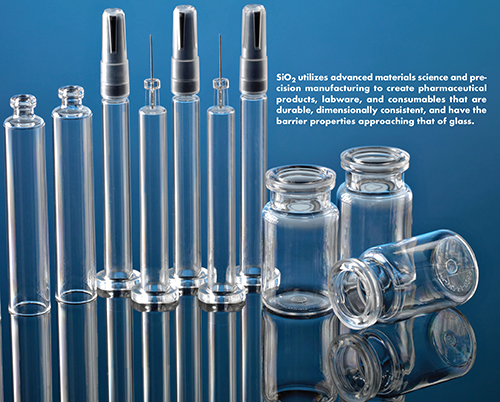
Eugene Polini, Principal Scientist, Technical Service, SiO2, explains how one client successfully used the product to contain an injectable radiopharmaceutical. “This drug product had an extreme sensitivity to metals from the glass packaging. Their switch to the use of COP mitigated any risk from this issue because of its very low inorganic contaminant level. This allowed for the successful storage and delivery of the drug product with reasonable shelf life.”
Sonceboz: Simplified Use Avoids Manual Filling & Eases Comfort
Sonceboz is focused on developing a wearable device platform that delivers large volumes from known primary containers. The company designs both a drive and device platform solution that can be quickly adapted to specific intended usecases: single-container devices for large-volume injection; dual-container injectors for sequential drug delivery; and a wearable injection device featuring automatic reconstitution of lyophilized biologics.
“We are designing the core of our technology platform (user interface, user-steps, internal mechatronics, and pumping system) for challenging therapeutic applications such as Rheumatoid Arthritis,” says Thomas Mayer, Sales and Application Manager, Sonceboz. “However, we are also targeting the biologics and biosimilars applications offering vast possibilities to our pharma partners.”
Sonceboz designed its device platform based on user input from patients suffering from Rheumatoid Arthritis. “We selected RA as our intended use-case because we believe this condition displays a challenging application due to symptoms such as impaired movement or dexterity, as well as a very homogeneous patient group,” says Mr. Mayer. In October, Sonceboz will have the results from formative human factors studies.
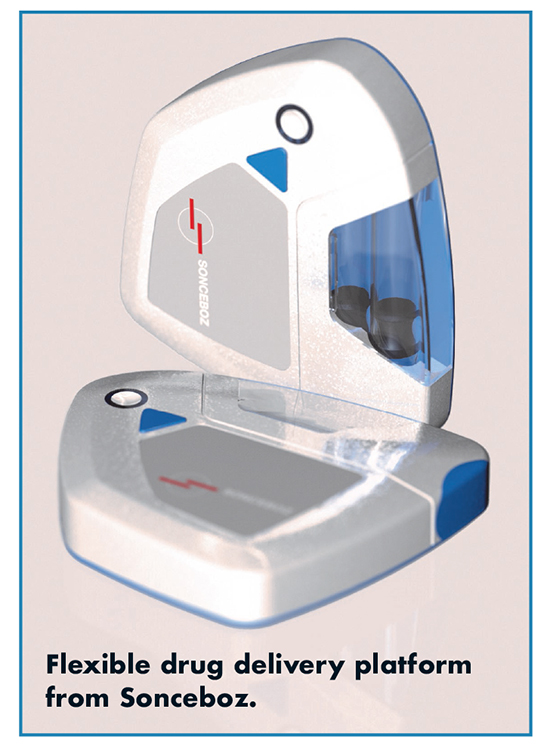
From the first design iteration, the focus is on ease-of-use, offering simple preparation steps and avoiding the manual filling of the device. “In our design, the user simply inserts a drug-cassette that contains the primary container as filled by the pharmaceutical company,” explains Mr. Mayer. “This ensures ease-of-use for the patient and enables the use of known primary drug containers.”
To avoid needlestick injuries, the platform comes with a Dynamic Needle Insertion System that only engages the injection needle once proper skin contact is established, and immediately retracts the needle into the device after initial skin piercing, leaving behind only a soft-cannula for increased patient comfort.
Mr. Mayer adds that Sonceboz has integrated Bluetooth Low Energy communication technology into its wearable device platform, intended to provide one-way data transmission from the injection device to a third-party device such as a smartphone.
West: Designing Devices that Fit Into a Patient’s Lifestyle
Given the industry trend toward self-injection delivery systems for the treatment of chronic conditions such as diabetes and Rheumatoid Arthritis, West has focused on creating products that are designed with the patient in mind. “In particular, we’re seeing a lot of interest in integrated delivery systems that meet the unique challenges of containing and administering biologics,” says Eric Resnick, Vice President & Chief Technology Officer, West Pharmaceutical Services, Inc.
One of the most promising options for administering these treatments is wearable drug delivery technology that combines the drug and its primary containment system in a patient-friendly system that delivers the prescribed dose electronically.
West Pharmaceutical Services’ SmartDose® platform, for example, was designed with extensive human factors testing and analysis to integrate into a patient’s lifestyle. The platform is a single-use, electronic wearable injector that adheres to the patient’s body, usually on the abdomen. Discreet, intuitive, and designed to minimize discomfort, SmartDose technology incorporates a polymer-based drug container (made from Daikyo Crystal Zenith® cyclic olefin polymer) with a drug delivery device that can be pre-programmed to deliver high volumes of viscous or sensitive drug products over time, making it easier for patients to self-administer medication outside of the clinical setting, explains Mr. Resnick.
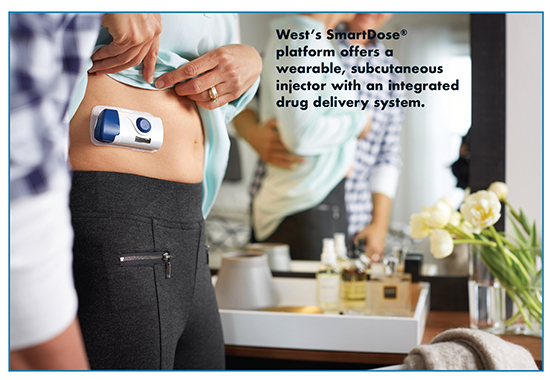
West collaborated with Amgen, which needed to deliver a high monthly single-dose (420 mg) of its drug Repatha® (evolocumab) via injection. “Ultimately, Amgen selected our SmartDose platform because it could support that dosing level, and improve the patient experience, allowing them to perform moderate physical activity (such as walking, reaching or bending) as the drug is delivered subcutaneously,” Mr. Resnick says.
West has also partnered with HealthPrize Technologies to integrate their Software-as-a-Service medication adherence and patient engagement platform with West’s injectable drug delivery systems, effectively providing an end-to-end connected health solution to pharma companies and the patients they serve. The app tracks when patients take their medication, educates and engages patients to help increase adherence and medical literacy, and rewards them for compliance. Next-generation devices under development currently will include expanded connected functionality.
In addition to easing the self-administration process, the heightened focus on quality by regulatory agencies, especially in particles, extractables and leachables, and container closure integrity, is a focus for West. This, combined with the growing use of biologics and the trend toward self-administration, means manufacturers need to select packaging components that have high levels of reliability, consistency and compatibility with sophisticated drug products, says Mr. Resnick. “That’s why we use quality components for our SmartDose platform such as a Daikyo Crystal Zenith drug container with elastomer components using FluroTec® barrier film. Once we have quality accounted for, it’s our human factor analysis that helps keep our delivery systems easy and appealing for patients to use.” Mr. Resnick adds that the secondary packaging design has to take into consideration the user interface so that the device and drug container are easily acceptable while also providing the necessary product protection and sterility assurance.
Ypsomed: Self-Injection Devices Designed With Patients & Apps in Mind
Following the overall success of its customizable disposable UnoPen and 1 mL and 2 mL YpsoMate platform products, some customers are looking for higher constant injection forces for increased drug viscosities and to decrease the injection time for 1-2 mL injections. For these applications, Ypsomed has developed YpsoMate 2.25 Pro which is being adopted by a number of pharma clients.
Ypsomed is also focusing on the largevolume 2-10 mL YpsoDose patch injector, which is attached to the skin during injection. The targeted therapeutic indications are biologic drugs that require the injection of higher volumes with potentially reduced injection frequency compared to a treatment with autoinjectors. As a wearable device, YpsoDose is a prefilled and preassembled, electromechanical, cartridge-based, connected device, based on a versatile platform that may be customized into product specific variants, explains Ian Thompson, Vice President Business Development, Ypsomed.
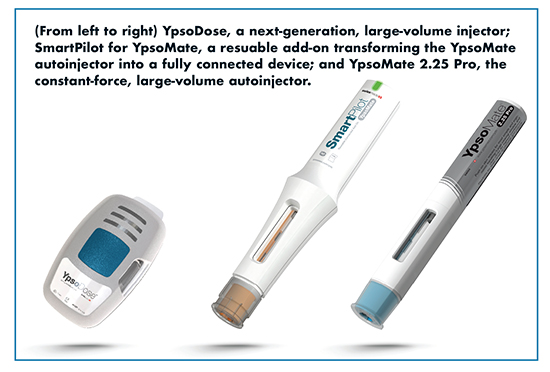
In the area of connectivity, Ypsomed is focusing on the smart, connected add-ons such as SmartPilot for YpsoMate. SmartPilot transforms the standard YpsoMate autoinjector into a fully connected device, detecting and communicating different use states of the autoinjector to a smartphone, providing real-time, step-by-step instructions in written, animated, and audible formats, improving patient adherence and therapy outcome. In a commercial setting, SmartPilot connects the patient with different stakeholders (doctors, pharma industry, payers) that may take advantage of the collected data. SmartPilot may also be used during a clinical study; Ypsomed will demonstrate a clinical use-case during the 2017 PDA conference in Vienna.
New wearable injectors are more complex than autoinjectors and need to be handled simply, safely, and effectively by patients. YpsoDose is being developed to keep the number of handling steps to an absolute minimum. YpsoDose is attached to the skin and activated by pressing a button. Needle insertion, injection, and needle safety are performed automatically. All usability aspects such as patch characteristics, size and weight, and visual/audible feedbacks are being tested with patients in parallel to the technical development process.
“Connected devices, such as YpsoDose and SmartPilot require new approaches to Human Factors testing,” says Mr. Thompson. “The attention of the patient is no longer focused solely on the device, but also on the use of smart apps, so it is important to test the device in combination with the connected smartphone.”
As an example, Ypsomed is applying eye-tracking methods in the development of SmartPilot to track the attention of the user during device operation to help improve both the device and app interfaces.
References
1. Injectable Drug Delivery Market by Type (Device, Formulation), Therapeutic (Cancer), Usage Pattern (Immunization), Administration (Skin, Musculoskeletal), Distribution Channel (Hospital), Patient Care Setting (Hospital, Home Care) – Forecast to 2021, marketsandmarkets.com, Feb. 2017,http://www.marketsandmarkets.com/Market-
Reports/injectable-drug-delivery-market-150.html.
2. Large Volume Wearable Injectors Market (3rd Edition), 2017-2027, Reportlinker, Feb. 23, 2017, http://www.prnewswire.com/news-releases/large-volumewearable-injectors-market-3rd-
edition-2017-2027-300413116.html.
Total Page Views: 10579









